This no-knead artisan bread recipe is perfect for beginner bread bakers. Made with instant yeast and baked in a Dutch oven. Follow my easy step-by-step photos and instructions to bake this simple bread at home!
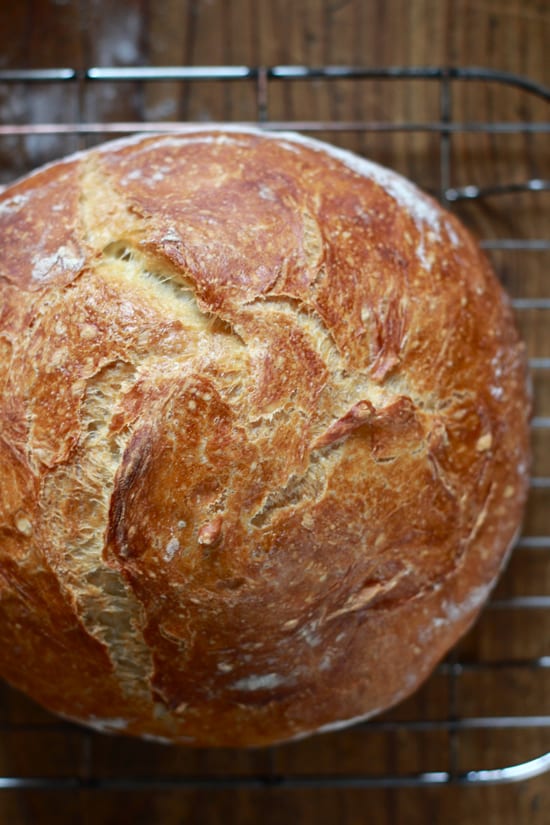
Interested in baking your own bread? Jim Lahey’s No-Knead Bread recipe uses an incredibly easy formula: Simply mix up the dough and let it rise overnight. You don’t need a stand mixer or a bread machine, and there’s no kneading involved! Just 2 minutes of prep time and the rest is hands off. The result? A gorgeous, perfectly golden crusty loaf with a soft and chewy interior.
YOU WILL NEED:
- 5 1/2 qt. Dutch Oven (or another oven-safe pot with lid)
- Bread Flour (Target has the best price)
- Instant yeast
- Parchment Paper
- Container (for the dough to rise)
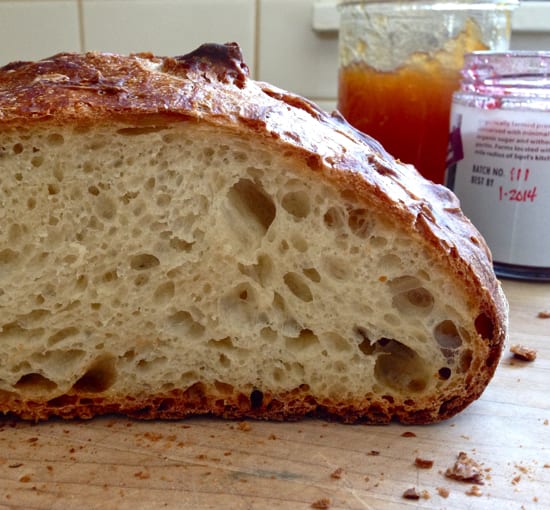
How To Make Easy Homemade Bread
Step #1: Mix The Dough
First things first: Clear away all kitchen clutter and find yourself a nice workspace. This includes all bills, kids’ toys and random phone chargers. Then, in a large bowl add the dry ingredients (flour, yeast and salt) and mix with water to combine. As it becomes difficult to stir, get in there with your hands and mush everything together. It will be wet and sticky, with a shaggy appearance…
Instant Yeast vs. Active Dry Yeast: What’s The Difference? While both types of yeast make bread dough rise, instant yeast can be added directly to the bread dough along with the rest of the ingredients. Active dry yeast needs to “bloom” first in water before using. This recipe uses instant yeast, although active dry yeast can be used with the blooming modification step mentioned above.
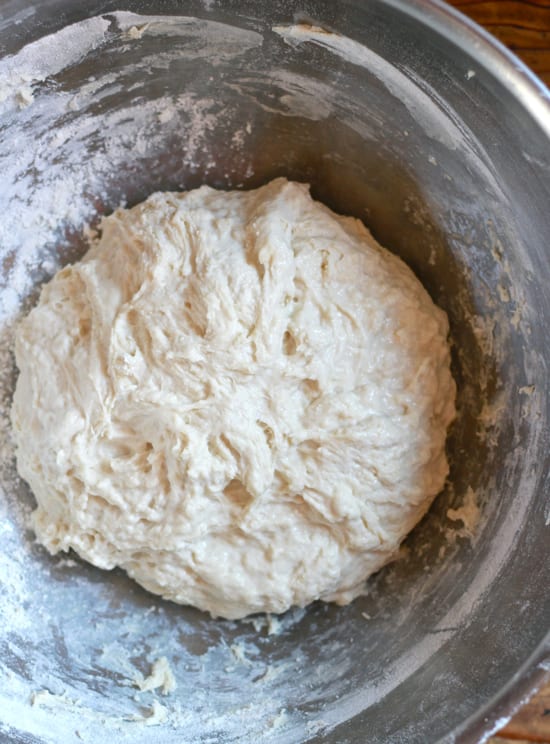
STEP #2 LET The Dough RISE
Transfer the dough to a lightly oiled container and cover loosely with oiled plastic wrap. Let the dough rest at room temperature (about 70 degrees F) for 14 hours- overnight. Your dough is ready when it has puffed up in volume, about 1 1/2- 2 x the original size. You will also see lots of bubbles.
TIP: If your dough isn’t puffed and bubbly after the initial rise, place it in the microwave with the light on (keeping the door ajar). The warmth from the light will give the yeast a boost. My friend Celia gave me this tip and it works like a charm, especially in chilly kitchens!
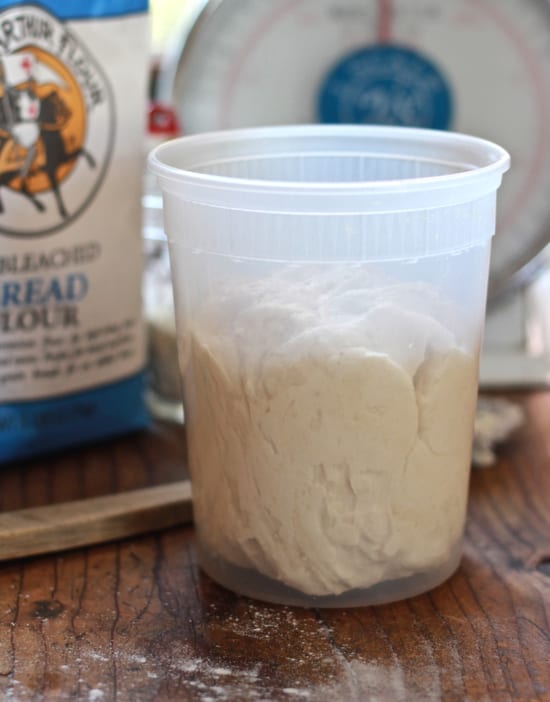
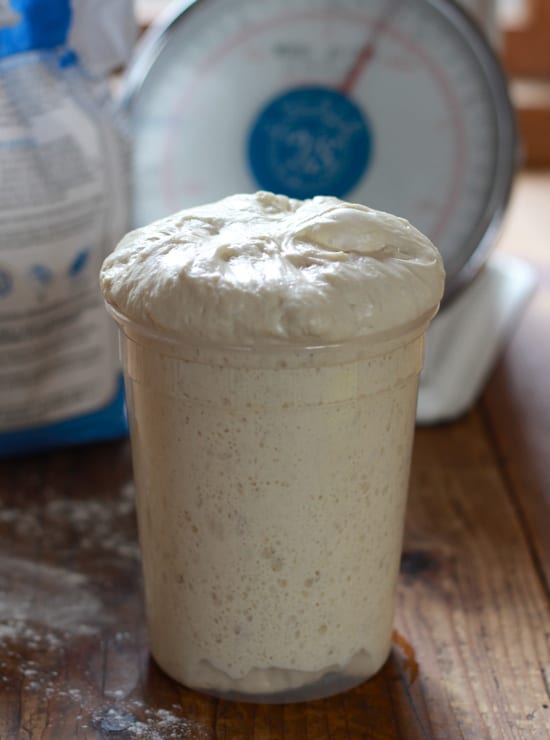
STEP #3 SHAPE THE DOUGH & LET IT RISE AGAIN
Flour a sheet of parchment paper. Remove the dough from its container and place it on top. Fold it in half (like a book) and then fold it in half again. When you are finished folding, add more flour to the parchment paper (be generous so that it doesn’t stick). Shape the dough into a ball by gently tucking the sides underneath itself. Place it onto the paper seam side down, like so…
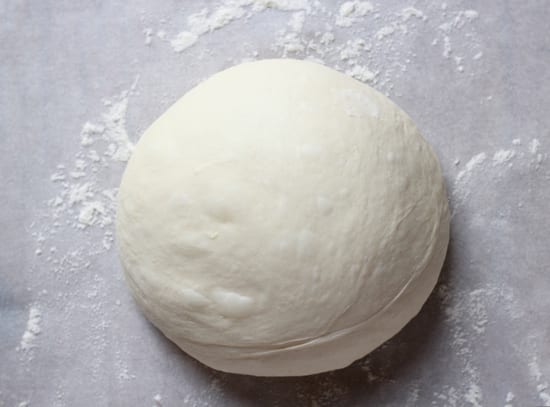
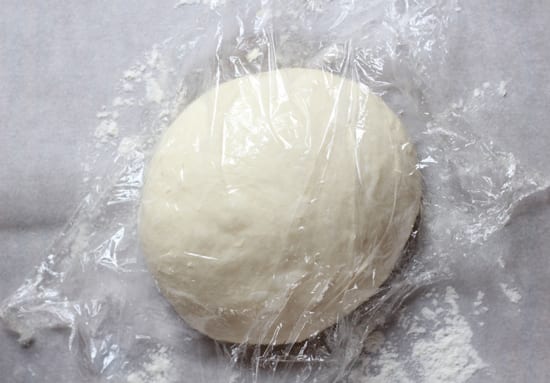
Cover loosely with oiled plastic wrap and let it rest again until puffy. It will start to spread out slightly as it rises- this is ok. The 2nd rise will not take as long as the first, but expect to wait about 30 minutes- 1 hour depending how warm your kitchen is.
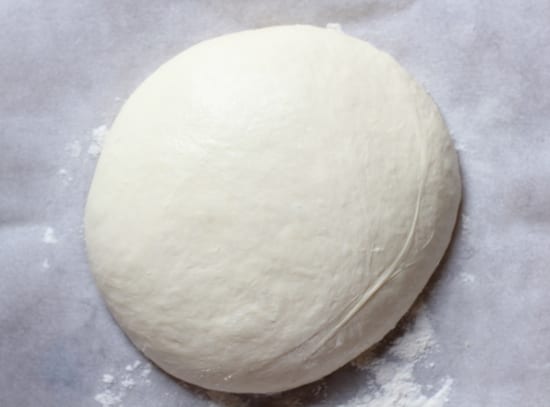
Step #4 Get Ready to Bake
About 1/2 hour before your dough is ready, preheat your oven to 500 F. Place a Dutch oven with the lid on top inside for 20 minutes to heat up. Why use a Dutch oven? Steam is essential in bread baking! The lid traps in the residual moisture which allows the dough to form a beautiful, artisan-style crust. If you do not have a Dutch oven, any oven-safe pot with lid will work. Just make sure it can heat up to 450 F.
When the Dutch oven is nice and hot, carefully slide your hand underneath the parchment paper and invert the dough into the pot. The seam will now be facing up. Take a look…
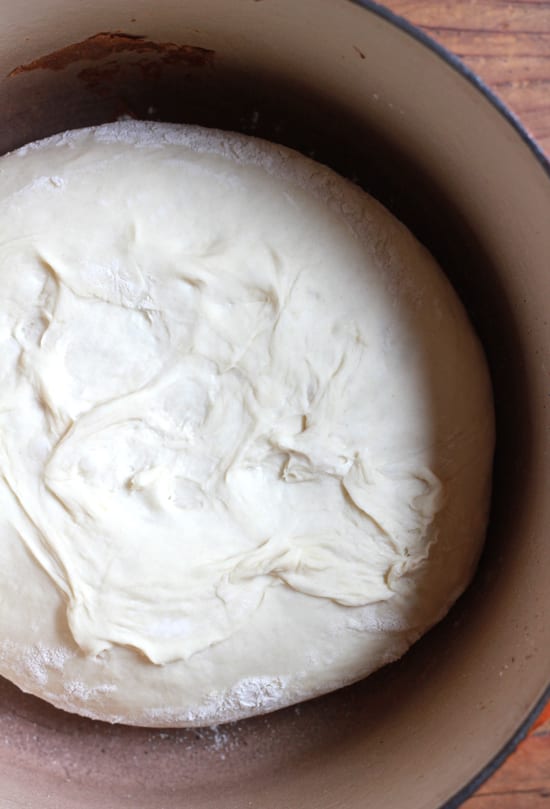
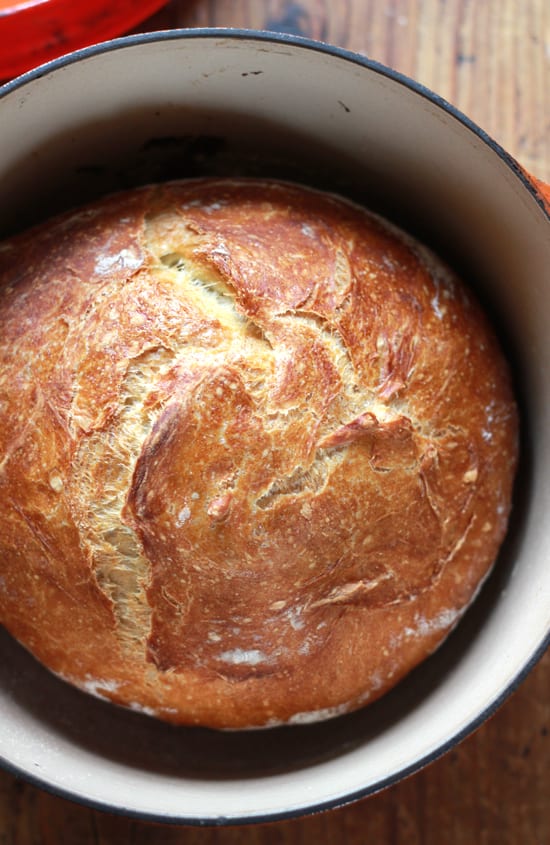
Step #5 Bake the Dough
Place the bread into the oven, and immediately reduce the temperature from 500 to 400 F. Bake with the lid on for 40 minutes (this will trap the steam inside making the bread moist). Then, remove the lid, and bake for an additional 15-20 minutes or until the crust is a deep, golden brown.
TIP: To be sure that your bread is fully cooked, I highly recommend taking its temperature. I use this digital thermometer and LOVE it. The internal temperature should read between 200-205 F for this recipe. If not, bake the loaf a little longer (extra time in bread baking is a good thing).
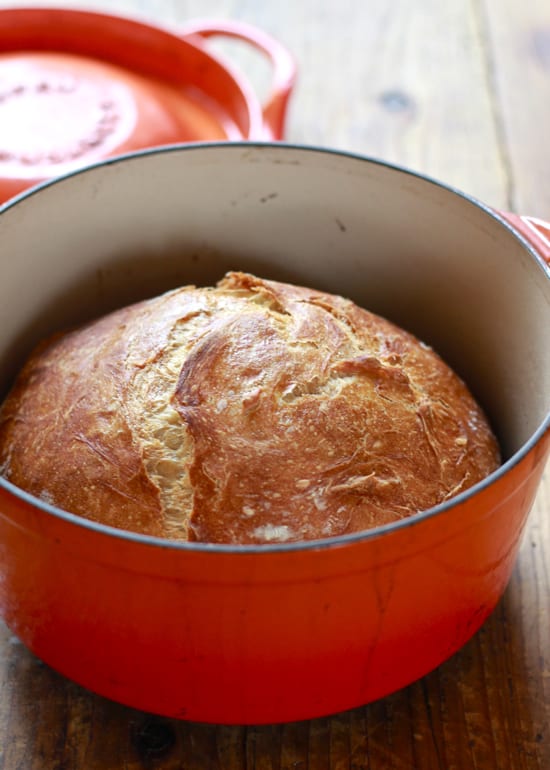
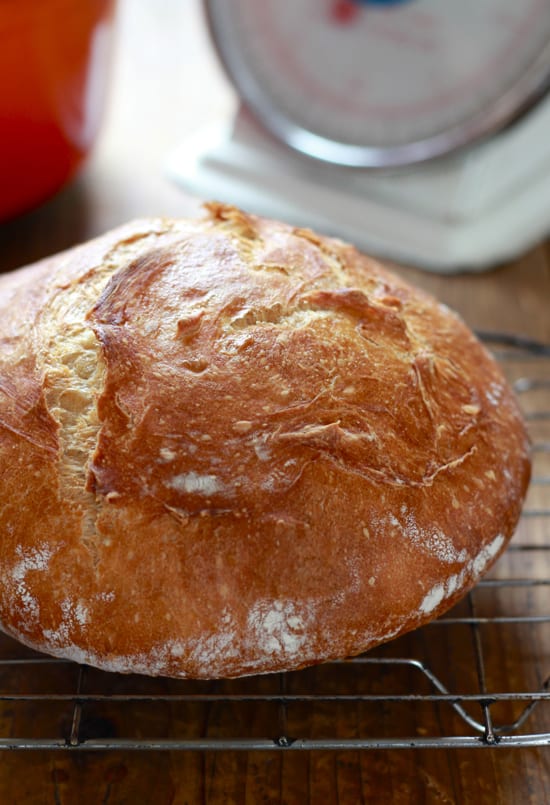
Step #6: Let It Cool
When your bread is done, remove it from the oven and transfer to a wire rack. It should feel light and sound hollow when you knock on the bottom of the loaf. You’ll also notice a wonderful crackling sound as it cools. Let it rest for at least 1 hour before cutting into it. Doing so too soon might ruin the texture of the bread, resulting in a gummy crumb! Trust me, I speak from experience. And there you have it- easy, no-knead artisan bread!
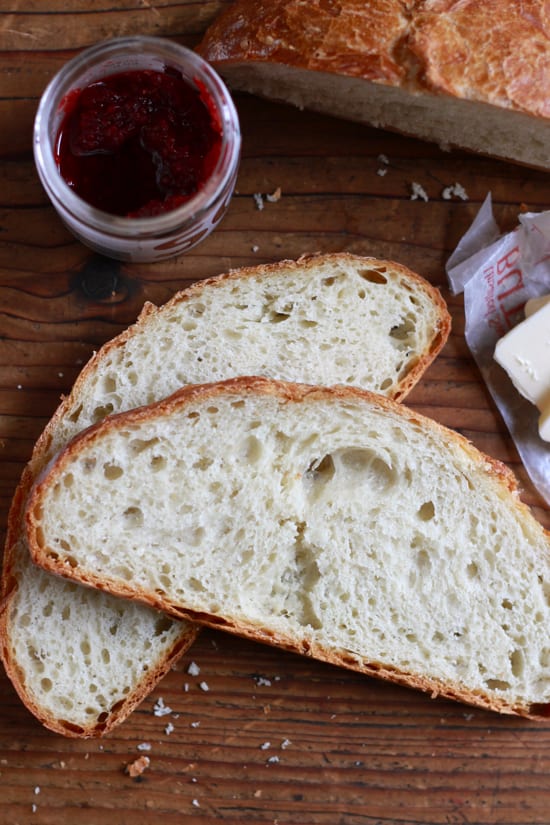
Final Thoughts…
For all you beginners out there, I had absolutely no clue how to bake bread when I first started. With practice, I’ve found that the no-knead approach is a great starting point for anyone. It will give you the confidence to take on more challenging recipes like sourdough bread, as you continue to develop your skills and intuition. To me, baking bread at home is truly a rewarding experience. And not only does it taste good, this loaf cost less than $1 to make!
Looking For More Beginner Bread Recipes?
- Light Brioche Hamburger Buns (fan favorite!)
- No-Knead Honey Whole Wheat Bread
- Pull Apart Brioche Rolls
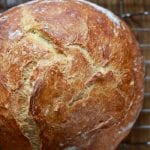
Jim Lahey’s Easy No-Knead Artisan Bread
- Yield: 1 loaf
- Category: Yeast Bread
- Method: Oven-Baked
- Cuisine: American
- Diet: Vegan
Description
An incredible recipe for no-knead artisan bread baked in a Dutch oven. I like to make the dough in the evening (after dinner) to rise overnight. It’s fantastic for sandwiches, crostini, and to mop up delicious sauces! Recipe adapted from Jim Lahey’s No-Knead Artisan Bread.
Ingredients
- 390g (3 cups) bread flour (not all-purpose) + more for dusting
- ¼ teaspoon instant yeast
- 1¼ teaspoons fine sea salt
- 320g (about 1 1/3 cups) water
Notes
I use King Arthur Bread Flour & SAF instant yeast. You can use any 5 1/2- 6 quart Dutch oven, cast iron, enamel, Pyrex or ceramic bakeware (with lid) that can heat up to 500 degrees F.
Instructions
In a large bowl add the flour, yeast, salt and water. Stir until a rough dough forms. If it seems very dry, add more water.
Transfer to an oiled container and cover loosely with plastic wrap. Let rise for 14 hours- overnight, at room temperature (about 70 degrees). Your dough is ready when it has puffed up in volume, about 1 1/2 -2x its original size. *See note below.
Lightly flour a sheet of parchment paper and place the dough on top. Fold dough in half and then fold it in half again.
Shape the dough into a ball by tucking the sides underneath itself, and place onto the paper, seam side down. Cover and rest again until puffy but not fully risen, about 30 minutes- 2 hours depending on how warm your kitchen is.
Preheat your oven to 500 F. Put a (6 quart) dutch oven pot inside for 20 minutes. When ready to bake, remove pot from the oven. Place your hand underneath the parchment paper and invert the dough into the pot. The seam will be facing up. Cover the pot with the lid.
Place your bread into the oven, and reduce the temperature from 500 to 400 F. Bake for 40 minutes, covered. Remove the lid and bake for an additional 15 to 20 minutes, until golden brown.
To make sure that the bread is completely cooked through, take its temperature. Carefully tip the bread onto its side and insert a thermometer into the bottom. It should read 200-205 F. If not, place it back into the oven until it is ready (extra time in bread baking is a good thing). If you’re worried about the top getting too brown, put the lid back on.
When your bread is ready, transfer to a wire rack to cool. It should feel light and make a hollow sound when you give it a knock underneath. Let it cool for at least 1 hour. Cutting it too soon might ruin the texture resulting in a gummy crumb!
Notes
If your dough isn’t puffed and bubbly after the initial rise, place it in the microwave with the light on (keeping the door ajar). The warmth from the light will give the yeast a boost. My friend Celia gave me this tip and it works like a charm, especially in chilly kitchens!
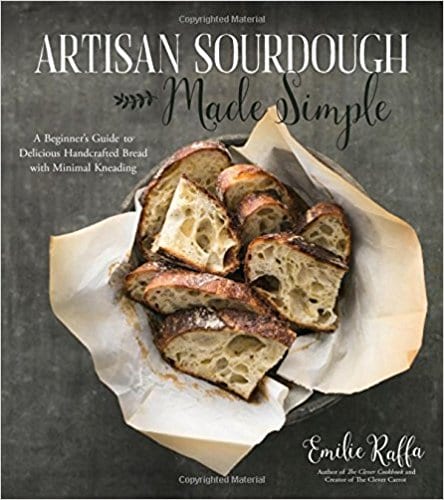

Comments
Roshi says
No Dutch oven?// no recipe state alternative bakeware
Emilie Raffa says
Hi there! Any oven safe pot with lid will work. Make sure it can withstand heat up to 450 F, including the handles.
Jamie says
Can Activated Dry Yeast be used instead of instant for this recipe? Would you just use the same amount and mix with warm water prior to mixing the dough?
Thank you!
Emilie Raffa says
Hi Jamie, yes and yes! :)
Denise says
This bread is amazing and super easy to make!!!
sydney says
This seems to be a good thread for the no-knead bread people, so maybe you can answer a question I can’t find an answer for otherwise: I’ve been successful with the no-knead recipe as is. I want to try making it into a sweeter bread. Possible? I want to try soaked raisins; cinnamon; and maybe a quarter cup of sugar with the original (18-hour) rise. Will the sugar wreck the chemistry of the recipe? Thanks!
Paul says
After reading a few of the more recent comments (excerpts noted in quotes, below) from other bakers – but not seeing a reply – I’ll ask a couple of similarly-related questions here:
1. My dough was also VERY sticky after the 14-hour period (“stuck to everything . .”), which made it very difficult to fold it, and later, after the second-rise period, invert it and put it into the Dutch oven, without having to pull it off the parchment with some effort. Would more flour on the parchment have helped with this? Was the dough too wet to begin with (even though I followed the measurements to a “T”)?
2. While the loaf baked nicely, I, too, ended up with a loaf that had “flattened out . .”, as opposed to keeping its boule shape when I formed it. This flattening actually started to occur during the second-rise period, so, again, I’m wondering what I could/should have done differently to end up with a loaf like the one pictured in your recipe. Thanks!
Emilie Raffa says
Hi Paul! This dough is indeed very sticky. It’s just the nature of the recipe- overnight doughs tend to be this way. But, the dough shouldn’t be so sticky that it’s impossible to work with. It could be a measurement error (too much water) or the brand of flour used (some brands absorb less water than others). And yes: more flour on the parchment paper will help. For flat loaves, based on what you described, it sounds like your dough was over proofed. When you do the second rise next time, place the dough in a cloth lined 8-inch bowl; this will contain it’s shape. Hope this helps!
Paul says
Thank you for the quick reply, Emilie! It all makes perfect sense and I will make these adjustments the next time.
Emilie Raffa says
You got it :)
Amy Norris says
I tried this but the dough was waayy too wet. There was a puddle in the bottom of the bowl and the dough couldn’t keep its shape at all even after adding quite a bit of flour to the parchment. Had to throw it out. Not sure what went wrong :(
Sara P says
This turned out SO WELL. Mine looks JUST like the photos, minus some uniformity, lol. I am a very impatient baker with a history of yeast related failures, everyone in my family is shocked I pulled this off. Definitely a go to recipe. For other readers, I used a ceramic casserole dish with a lid since I didn’t have a cast iron dutch oven, and it worked VERY well. I did not need anything in the crock because it was so hot nothing at all stuck, it looked nearly clean when I took the loaf out. Thank you for this recipe!
Emilie Raffa says
Thanks for your feedback, Sara! Glad you enjoyed it! xx
Renee Hewitt says
This bread is the best ..I added in herb and garlic seasoning to recipe ,came out awesome,added an egg wash with dried herbs on top with sesame,I did add a little more water to accommodate the added dry ingredients. Also did not remove the parchment paper and didn’t invert…. just cut a few slits to top used a cast iron 4 1/2 quart pot ..This bread is so forgiving ,Thanks for sharing
P.S.warms nice and toasty in an air fryer as well, a couple of minutes and just like it came out of oven! yummy yummy
Renee
Emilie Raffa says
Oh my goodness, I’m drooling. Seriously, I can just smell this loaf as I type! Thanks for stopping by with your feedback :)
J Bob says
Hi. Just getting ready to try this, and paused when I reviewed ingredients. Wondering if I’m confused.
1/4 teaspoon instant yeast I think is LESS THAN A GRAM?
That’s like, not a lot of yeast, nothing like a recipe I’ve ever seen. Did I read this right? 3 cups of flour and less than 1 gram of yeast?
Thanks kindly
J Bob
Veracruz
Emilie Raffa says
Hi there! 1/4 tsp of yeast is correct. Typically, when a dough requires a long, overnight rise it’s usually paired with a small amount of instant yeast. If you use too much yeast, the dough will rise too fast which defeats the purpose of the “low and slow” method. It’s not wrong; the method is just different and is the preference of the baker. As an alternative however, you could always use more yeast in this recipe, let the dough rise in a notably warmer spot, and it will most likely double in only a few hours. And then it would be a different style of bread altogether… make sense? Hope this helps!
Liz says
My first time baking a yeasted bread and it came out wonderfully. I feel like I’ve gained entry to a secret club—who knew making bread is so simple? I had always been intimidated by it.
Thanks for the excellent recipe. I’m looking forward to making this artisan loaf all winter.
Emilie Raffa says
Hi Liz! Oh, I’m so glad to hear that. And I totally know what you mean about the “secret club.” Bread baking can be intimidating at first, just because it’s not something we normally do everyday, but once you get the hang of it, it’s quite liberating, don’t you think? Happy baking!
Jacqui says
Hi. The first time I made this loaf it was perfect but since then I’ve had a couple of problems.. the dough rises massively within 10 hours – should I leave it for another 4? Also the dough was so sticky that I couldn’t fold or shape it and it stuck to everything! Is this because I’m not leaving it to rise for the full 14 hours or should I be adding more flour/less water?
Thanks
Jacqui
dianne says
This is a fabulous recipe. I make it ALL the time and it’s delicious! I used the recipe originally because I had some left over bread flour –I had always used a.p. for no-knead bread before trying this.
I tend to let mine rise for about 24 hrs instead of 14 and it works and tastes great.
The only problem I had with no-knead breads were the way they tend to flatten in the dutch oven making the slices from the loaf longer and skinnier than I prefer.
I tried using a bit less water (dough seems to hold it shape better for me) and cooking it in a 3.2-quart dutch oven. Cooks in the same time as the recipe and produces a rounder loaf.
I thank you so much for this great recipe!
Violeta Spirkoska says
This is a lovely recipe, but I do find the dough way too sticky. I added quite a bit more flour. I also added quite a bit more yeast as I did not think it was enough for the quantity of flour. I’m no expert baker but I have made bread on the odd occassion and usually use more yeast. The cast iron worked beautifully and no oil required. I loved the result. I added olives to mine as my family all love olive bread. Wonderful results. Thanks so much for the recipe.
Emilie says
Hi Violeta! Sounds great! Baking is all about adapting the art and science to your personal preference and you sound like you’re well on your way! Thanks so much for sharing your feedback with us. And the addition of olives sounds great! I happen to be a huge olive fan myself. :)
Carmella says
Hello, Is it necessary to complete the 1st rise in a separate bowl or can i let it rise in the mixing bowl?
thanks
Emilie says
Hi Carmella,
You can certainly do the 1st rise in the mixing bowl. No problem!
Robin says
Eager to make this bread but I only have a 4 quart Dutch oven. What do you think would happen if I halved the recipe? I’m afraid if I made the full recipe, it would be too much volume for the Dutch oven.
Linda says
My question is about preheating the dutch oven — as most manufacturers do not recommend heating a dry pan. I am concerned about cracking the interior. You have not had any problems with this?
Emilie says
Hi Linda,
I’ve never had a problem with this, but I’m only speaking from my experience. If you don’t feel comfortable preheating your pot, you don’t have to. Put the dough in cold and bake it following the recipe instructions.
Minty says
I’m having problems with the second rise. My yeast and flour are fresh, I get a wonderful first rise after 12 – 18 hours, but when I take it out of the container and fold and shape it it becomes flat and runny, and does not rise again at all. What is the problem?
Emilie says
Hi Minty,
The second rise is always the most challenging to judge. And there could be a number of reasons for a flat and runny dough. I would shorten the bulk rise (first rise) to 12 hours. When doing the second rise, place the dough in a cloth lined bowl (8 inches is good) to prevent it from spreading. Let is rest for 30 minutes. Then, continue with the rest of the instructions and see if that helps. Good luck!
Rochelle Pederson says
Found this recipe last night and followed it to the letter. Made the most perfect loaf of bread on my first try! Great tutorial. Wish I could post a picture of it. Never using another recipe for bread again.
Emilie says
That’s fantastic! Thanks for the feedback- So glad you had a successful loaf :)
Sarah says
Hi there! I’ve been making this bread for a few months now and I still love it! I’ve been experimenting with whole wheat flour and have found that half white and half wheat makes a delicious loaf! I also double this recipe without any problems. I live in Chile and haven’t found real bread flour so I’ve always just gone with all-purpose and its always good! Thanks again for the tutorial! Cheers!
Sarah says
I made this last night/today and I finally just took a bite…IT IS SOOO GOOD!!! My bread usually comes out way too lofty and it can’t even stand up to soft butter. This bread, however, is sturdy and has tons of flavor. It looks like something I could buy from Sainsbury’s. I am so proud of myself! Haha thank you for posting this recipe, it’s changed my bread game forever. I’m going to make another loaf tonight/tomorrow! (cause I’m pretty sure my husband and I will eat this whole thing tonight haha). Cheers!
Queene says
H.E.L.P. – I would like nothing more than to master this recipe. Have tried it twice and twice I got the same results. Followed the recipe exactly, specifically,…to the “T”. Still the results were no where as illustrated. First try resulted in a thick, hard crust (nearly cracked a tooth!), with a thick, heavy and dense inner bread. No nooks and crannies. Second attempt was pretty much the same but since I pulled it out before browning too much, the crust wasn’t as hard. Still, dense inner bread. I know from past baking experience, I am NO baker but this is one I thought I’d have no problem since it sounds SO easy. I would appreciate any help since this is one baking hurdle I really want to accomplish because my troop at home inhales ANY artisan bread within 50 feet of them. Thanks so much.
Alicia says
I have had the same problem!! I’ve tried this twice with the exact same results you’ve described. Its so disheartening, since the peasant bread on this blog works perfectly every time. I don’t have a dutch oven, I’ve been using a ceramic pot with a lid, but I think it may be the problem. Oh and the dough doesn’t rise at all (cold house syndrome), but even when I put it in the oven after turning it on for 1 minute (this trick works perfectly for the peasant bread) it still doesn’t rise :(
Dina says
Hi, Emilie.
My mom is 85 and she’s been baking her own bread since she was a child. Naturally, I’ve been using her method but it’s the traditional way, with lots of kneading etc. and it’s not easy to find the time… When I saw your recipe yesterday, I jumped on it. I was preparing a lunch for friends today and thought it would be lovely to be able to offer fresh-baked bread. I followed your recipe and tutorial with the following exceptions: I didn’t have time to go to the store for bread flour so I used all-purpose (I figured if it’s a bust, I had a back-up store-bought baguette I could serve) and instead of a round Dutch oven, I used my oval 4.5L Le Creuset.
It’s clear to me the bread flour would raise this loaf to the next level however, it came out quite good. Lots of little air pockets and gorgeous crust, everyone loved it.
I noticed some folks who posted here had trouble with the dough sticking to the parchment paper, even when well-floured. My trick, (my mom’s trick actually), is to rub my hands with a small amount of olive oil before I handle the dough. I ease it from the paper with little disruption and also don’t get any of it stuck on my hands which can cause the dough to deflate and collapse. If you like, I can send you a photo of the final product.
Thank you for a great recipe, I am back to making home-made bread now, thanks to you.
Dina
Emilie says
Hello Dina!
Oh, this is such a wonderful story. Thank you for sharing this with me. The no-knead method is absolutely fantastic and sure saves a lot of elbow grease! I use this same method for my sourdough as well… and thank you for the tips about sticking! This is why bread baking is so great- there are so many different tips & tricks to share. Just lovely.
PS- I saw your pic on Insta! All you need is some of your golden olive oil for dunking… xx
Irene says
Hi Emilie, I made the bread today and I noticed that the initial step of combining 3 cups of flour and 1.5 cups water produced a very dry and crumby dough. It seemed that there was too much flour for the water to wet. I did manage to knead it all together because stirring it didn’t bring it together. I let it rise for 18 hours, and then 3 hours after, but when I flipped it into the hot pan I noticed that it did not rise but stayed pretty flat after I flipped it into the pan. It still looks and tastes great, but I am wondering if my dough was too dry and if I let it rise for too long in the second rise? I am going to try it again and see if i can make something that looks closer to your photo.
Thanks. I love your website, especially the gorgeous pictures!
Emilie says
Hello Irene,
Thank you for your note!
For this particular dough, it’s best to begin stirring with a spoon and then switch to mixing with your hands (which I think you did). This will hep to ensure that the flour absorbs all of the water. It is stiff in the beginning, but after your keep wiring it, it will come together nicely.
With regards to rising, the initial 18 hours wass fine, but the additional 3 hours was too long. This is the reason why your bread came out flat (not because the dough was dry). Next time, shorten that second rise to about 1 hour or so and you should see a difference.
Hope this helps!
Merielle says
This was so easy…I have rheumatoid arthritis and can no longer knead traditional recipes…I haven’t been able to make good bread for several years (I know they are convenient but I don’t like bread machine bread). Rhis was perfect. The only issue I had was my loaf shape disintegrated when I was putting it in the Dutch oven…I just put the lid on, popped it in the oven, and crossed my fingers! It came out perfect! Can’t thank you enough…I shared the heck out of your page all over my social media!
Jorge Costa says
Hi Emilie. Very nice article.
I have 2 questions:
Do you add yeast and salt at same time?
And do you use air circulation on the oven?
Many thanks
Emilie says
Hi there! Yes, add them both at the same time :) You can use convection if you’d like, but it’s not necessary.
Lynn says
Hi Emilie, we love the crust and taste of this bread, however, we end up with a doughy interior, not at all what yours looks like. We do live in a very humid area. Our dough seems to spread before rising, so we have somewhat of a disk at the end of rising. Could we use less water and more yeast to get a firmer dough that won’t spread? Any suggestions? We’ve made 5 of them up to now and are itching to get it right.
Emilie says
Hi Lynn,
Spreading is normal when bread dough rises, especially when the water content or hydration % is particularly high (like this recipe).
There are a couple of things you can do:
1.) Add more flour to the dough- this will help to firm it up, and it will be easier to handle, however the interior won’t have as many open holes.
2.) Allow your dough to rise in a cloth lined basket or banneton, both dusted in flour. This will contain the dough’s shape as it rises so it won’t spread out to the sides.
Also, if the crust is brown on the outside and the inside is doughy, your bread is undercooked. Try lowering the baking temp by 25 degrees, and/or keep the lid on a little longer. You will need to cook out all of the water for the dough to become light and fully cooked through. Extended baking time with the lid on will help.
Good luck! Let me know how it goes!
Lynn says
Emilie, thanks SO much for your prompt reply. Attempt #6 today failed, but we’ll try another one shortly using your suggestions and will let you know.
Thanks again,
Lynn
Emilie says
No worries, I know the feeling ;) Please let me know if you have any other questions! Good luck!
Lynn says
Emilie, attempt #7, much closer, but still a little doughy. I adjusted covered time and cooking time, and lowered the temp, as you suggested. I really think part of it is our high humidity. Attempt 8 coming up shortly. Will see if there’s a way I can post a picture.
Laura says
Hi, do you think you could make his with spelt flour? Also, do you think a stainless steel caserole pot with lid would work as a Dutch oven substitute? Thank you!
Emilie says
Hi Laura,
Sure. It depends on how much spelt flour you want to use- 100% will yield a more heavy and dense bread, compared to my artisan loaf. I would replace a small amount with spelt flour first and take it form there. Experiment until you find what you like. It’s a matter of personal taste. You’ll have to increase the water as well as whole grain flours absorb more than regular & bread flour.
M-R says
I once tried to make this, and ended up driving Jim mad by email with my constant whingeing about my inability to produce dough ‘dry’ enough to even fold over !
So I have boiled Jim’s recipe down to something so simple, even *I* can produce a perfect loaf every time. :)
Perfect Bread
Ingredients:
• 450g baker’s flour
• ¼ tsp yeast
• 1 tsp salt
• 350ml water
Method:
combine first 3 ingredients in bowl that gives you room for stirring, and mix them well
add water by thirds, incorporating by hand each time: the dough will end up wet and sticky (and this is as it should be)
cover bowl with plate and put aside somewhere that isn’t cold
leave for a minimum of 12 hours (any extra time is unimportant – it simply depends on what suits): next day the dough will have risen lots, and be completely full of tiny bubbles
put an empty lidded pot into oven, set to 250º and let it heat up for 25 min.s
with hands well protected take pot out and transfer dough into it; put lid on, put bowl back into heated oven, set timer and bake at 250º for 30 min.s (I like to bake for half the time in one position and the other half turned 180º)
remove from oven, take lid off pot; re-set timer for 20 min.s and put back in (ditto)
remove pot from oven and loaf from pot; put it onto a rack to cool
Don’t cut it before an hour of cooling!
Emilie says
Fantastic! Persistence pays off, doesn’t it? Glad you found something suitable for you. I’m sure your loaves are beautiful.
silva says
have you ever tried adding sunflower seeds or other seeds in it? how about other flours? like rye? i really want to try but I’m not sure if i have to make adjustments to the water, and if you have tried i would appriciate it if you can share what and how. Thank you
Emilie says
Hi Silva, you can absolutely play around with this recipe but it will take some trial and error. I know that whole grain flours including whole wheat and rye will benefit from additional water (as you mentioned). Seeds, dried fruits, and nuts need to be soaked before adding to the dough. Unfortunately, I cannot give you specific measurements or amounts as I have not baked these alternate versions myself. Don’t be afraid to experiment! Make bread crumbs or French toast if it doesn’t work out. Best of luck ;)
Abby Tonks says
This bread is the best! I was a little hesitant over the long baking time and high temperature, but I have made it three times already, and it always comes out gorgeous. Really amazing and tasty. I always thought it would be impossible to make an artisan bread without a wood fired oven. I am a potter, and now I feel inspired to create some bake ware just for this bread. I can’t wait to try your other recipes!
Emilie says
Thank you so much Abby! It’s wonderful to hear that you liked the recipe. Baking at a high temperature always is a little nerve-racking but it’s so important in bread baking in order to get a nice, high rise. isn’t it a good feeling knowing that you can replicate similar results at home? Bread baking is a beautiful art. I would love to see some of your artistry work. Homemade bakeware would be perfect for this :)
Mary says
Hi there,
I’ve made this twice and while it tastes amazing – my loaves aren’t coming out as tall as yours. I follow along with each step and the dough looks like it’s tracking right along with the recipe. Any ideas why my loaves could be coming out a little flatter? Thanks for any help!
Mary
Emilie says
Hi Mary!
I apologize for the late reply (somehow I missed this one!)-
There are a couple of reasons why your bread could be coming out flatter than the pictured loaves.
My guess is that it wasn’t shaped tightly enough before going into the pot (causes spreading), or the oven wasn’t hot enough to allow an adequate oven spring (rise).
As a solution, make sure that when you’re shaping the dough into a ball, that you create a good seam underneath to keep it together. It needs to be tight. This definitely takes a little practice, as I struggled with this when I first started baking. In addition to shaping, instead of letting the dough rise on a sheet pan, place it in a cloth-lined, floured bowl (small) or brotform if you have. This will hold its shape so that it doesn’t spread out. Then, invert the dough into your Dutch oven right before baking. And finally, double check the temperature of your oven with a thermometer for accuracy. The hotter it is, the better the oven spring!
I hope these suggestions help. Do let me know how it goes, and if you have any other questions I’m happy to help :)
Diane Radford says
I have been making this no knead recipe for a little while and I form the loaf on the parchment paper and when it’s time to bake the loaf, I just cut the parchment a couple of inches larger than the loaf and plop the whole thing down in the dutch oven.
Emilie says
Hi Diane! That’s actually a great idea- so much easier to transfer. Thanks for the tip! :)
susanne ellis says
This bread is fantastic! Glorious! I am from Germany and that is the best bread I had (homemade or purchased) since coming to the US in 1997! It reminds me a lot of loafs of bread I had in France. Now if I could only find a great recipe for rye bread and I’d be in bread heaven!!!
Thank you so much for this wonderful recipe. =)
Emilie says
Oh my goodness! That is SO great to hear! It really is hard to find good bread these days, especially in the supermarkets. It makes me so happy that you had success with this particular loaf. Isn’t it yummy? I pretty much bake all of my bread from scratch these days, supplementing with store-bought here and there. I don’t have any recipes for rye bread, but if I come across one I will definitely post a recipe. Thanks for stopping by Susanne :)
Peter G says
I have a very similar recipe and find using a light beer for about 1/3 of the total liquid works very well.
Emilie says
What a great substitution! I’ll have to give that one a try (it’s always good to have these tricks up your sleeve) The beer must add some good flavor too… :)
William Riedinger says
The bread tastes great and easy to make. The only problem is that I end up with larger bubbles at the top. I noticed in the photo above that the bubbles are more evenly distributed. Any suggestions?
Emilie says
Hi William,
Just to be sure- which photo are you referring to? This way, I’ll have a better idea on how to advise. Thanks! :)
William Riedinger says
The 2nd photo from the top.
To analyze it further your bread has overall larger air “bubbles” mine tend to be finer towards the lower half of the loaf with the upper ones larger(1″ ea.) which makes the upper crust paper thin
Emilie says
Hi William,
There could be several reasons for experiencing an ‘uneven’ crumb.
Based on my personal experience, possible factors include:
1.) Dough was too cold- whenever I bake with dough straight out of the fridge, the crumb towards the bottom crust is always finer or more dense. The loaf of bread itself is also heavier. So now, whenever I fridge proof I like to do the second rise at room temperature for at least an hour, (sometimes 2) depending on how cold the kitchen is and how puffy the dough looks. As a result, the crumb and overall loaf is pretty even in texture, fluffy and light.
2.) Are you using the Dutch oven to bake? Sometimes if you take the lid off too soon, the outside crust will harden before the bread has had a chance to fully rise. This will result in an open or big crumb towards the top crust. When then bread can no longer expand, the crumb towards the bottom crust becomes more dense. Does that make sense? Maybe keep the lid on longer to trap in more moisture which is essential to good oven spring and bread expansion.
I hope this helps! Please let me know how it goes if you continue to experiment or if you have any other questions :) Best, E
William Riedinger says
Thank you for taking time to offer suggestions. I reviewed your original instructions and noticed that you put the dough in the dutch oven upside down. I had tried doing that the first time I made this bread and had difficulty in the transfer (sticking to the parchment paper even floured) so I was letting it rise and baking it with the P paper. I tried flipping it again and that solved the bubble problem but Ive found that I need to use a lot of flour and the dough is spread way more then yours (over 12″)making transfer even harder also your bread doesn’t have that much flour on it after its baked, I don’t mind some but not to excess
Angie | Big Bear's Wife says
my husband LOVES all kinds of bread. I am excited to give this a try!
pym says
lovely recipe..i am hungry. i have a very, very old oven which will only go up to 400-425 degrees will my bread come out okay? thanks
Emilie says
Hi there!
Do you have an oven thermometer? I ask because the temperature in old ovens can be off sometimes, even though you might think it’s heated to the correct temp. So if you have one, definitely use it! That will help.
Baking at 500 F helps to boost ‘oven spring’ or rise, so baking at a lower temperature may not give your bread that initial push it might need. However, I’ve baked bread at 425 F before and it came out just fine! It all depends! Go for it :)
linnyrae says
Thank you for such a great recipe and tutorial! I made the bread and fell in love! It is now my “occassion” recipe. Making 2 loaves tonight, 1 for new neighbors & 1 for a “Thank You”!!! Just wondering if anyone has tried to make a Roasted Garlic Loaf with this recipe. I have been contemplating mixing in a handful of garlic cloves when doing the folding step. Not sure if I should do anything to the garlic before incorporating into the dough. Any suggestions?
Emilie says
You are so welcome Linnyrae! I am SO pleased that you had success with the recipe. Isn’t baking in a Dutch oven amazing? Who knew?!
I’ve never attempted making bread with roasted garlic, but I’m sure there are several recipes out there on the internet that will help guide you. What a yummy idea.! If you end up making it this way, definitely let me know~ I’d love to try it out. Thanks for stopping by! :)
Trixie says
WOW!!! This bread is delicious! I added Herbs de Provence but that was the only change I made. It is perfect, and tastes just as good (maybe better) as the $7 artisan loaf sold up the street.
Thank you for the very clear instructions! This is my new favourite bread!
Emilie says
Hi Trixie!
I’m so glad that you liked the bread! Isn’t it yummy? I haven’t bought a loaf of bread in months ever since I started baking my own. I got hooked!!! I usually make my dough after dinner, let it rise overnight, and then bake it off in the morning. It’s a great routine. Then I pack my freezer full of bread to use whenever I need it. I think I’ll try it out with herbs de provence next. Sounds fantastic! Thanks for stopping by and commenting. I really appreciate the feedback! :)
linnyrae says
What a great idea!!! I LOVE Herbs de Provence but never thought of putting it in the bread. I love to sprinkle it on my steaks before grilling. Having it in the bread would be a GREAT accompaniment! Thanks!
Emilie says
Doesn’t that sound lovely? Maybe Herbs de Provence and roasted garlic… I think that will be a hit! ;)
chef andy says
This bread is GORGEOUS! It looks super tasty, I can’t wait to try it out!
Cynthia Larame says
This is great! My husband loves bread and as soon as he saw the picture he wanted some! I can’twait to get all of my ingredients and start making this recipe!
Thanks!
Laura (Tutti Dolci) says
Gorgeous bread, can’t wait to try this out!
alison@thisbloominglife says
Thanks for your encouragement of my bread. Yours looks absolutely amazing! What size pot do you use? I have one but wonder if it might be too big (26cm). Thanks.
Emilie says
Hello Alison,
Thank you!
I use a 6 quart dutch oven that is about 10 inches wide. I think yours will work just fine! If you’re a bit unsure, you could always use something smaller (see recipe for additional options!) Just make sure that your bakeware is at least 4-5 inches deep, has a lid/cover, and can be heated up to 500 F. Good luck! :)
sara says
Alison,
I use a deep soup pot and cover it tightly with foil since it doesn’t have a lid…and still absolute perfection!
sara says
I am very excited. Just pulled the finished product out of the over and it looks exactly like the picture. Now I have to wait impatiently for an hour until it’s cool enough to eat. Aaah! That may be the longest hour ever. I am very excited though. My daughter looked at me and said in her very blasé 19 year old way: You’re excited because you baked bread?” to which I replied “YES!”. I am sure it will be delicious! Thanks so much. I can’t wait to bake my next bread!
Emilie says
HOW WONDERFUL!!!!!! Don’t you just love when a recipe works out? Yes, I agree with you- the hardest part is waiting for the bread to cool! I’ve cut into it way sooner and the crumb turned out really gummy. I have no patience, but sure learned my lesson! And that’s funny about your daughter’s reaction…but trust me, I can relate to how you felt. Bread baking sure is an accomplishment! I haven’t bought bread from the store in weeks. I’m loving the fact that I can make my own now :)
sara says
p.s. So we couldn’t wait the full hour…family got cranky just watching the gorgeous bread…and they lovesd it…so here I am, a week later, about to bake my next loaf. I am also going to bake the individual Irish soda breads this afternoon (don’t you just love baking and cooking?!)…I’ll let you know how they turn out, of course, but I have no doubt they will be smashing!
Emilie says
Oh, I’m so glad that your first loaf turned out well! Quite motivating to bake more, isn’t it? I like to make a bunch of loaves and freeze them. This way I have my own little stash of fresh bread for sandwiches, soups, etc. I’m working on a honey whole-wheat version as well. I’ll share that with you as soon as I’m done tweaking the recipe!! :)
sara says
Emilie,
Since I have had such success with your recipe, any suggestions for making an easy and delicious, gorgeous challah? I have looked at lots of recipes but none of them have absolutely intrigued or inspired me.
Emilie says
Hi Sara! You know, I’ve never made challah before. But now that you’ve put the idea in my head, I will be on the look out for a good recipe. I will keep you posted!
PS- Great idea about covering your pot with foil instead of a lid. I’m glad it worked out!
Barbara Bamber | justasmidgen says
This is just the most stunning loaf of bread, Emilie! What an accomplishment and your instructions are so helpful. I’m in a sourdough course later this month and can only hope my bread turns out so pretty!! xx
Emilie says
Thank you Smidge! It was a lot of fun to make and I’m officially on the bread baking band wagon! I just received some of Celia’s sourdough starter in the mail. How wonderful that you’re taking a sourdough class. I hope you learn lots so you can teach me ;) xx
Anne @GtSlamseysFarm says
Wow, your bread looks fabulous. I never bother to knead my dough any more as it works so well without, but have never cooked it in a dutch oven. If I use my cast iron pan, do I need to grease it first or can I just plop the dough in?
Emilie says
Hi Anne,
I love cooking bread in the dutch oven! The lid traps the steam inside, and then once it’s removed the bread becomes a deep, golden brown. It’s amazing.
About your cast iron pot- The original recipe did not call for greasing the pot. I believe they recommended adding cornmeal to prevent sticking, but I didn’t do that (I’m not a fan of cornmeal texture on my bread). I read other versions of this recipe where they didn’t use anything at all, which is what I did.
I just preheated my pot (un greased) for 20 minutes @ 500F. Then I added the dough, reduced the temp. to 400F, and let it bake away. I’ve never has a problem with sticking.
If you’re a little unsure, you could always give your pan a little grease, or utilize the cornmeal method. Just make sure your pan is preheated. This might be good for the first time to test it out?
Do you plan on covering the pan with a lid? Just curious…
Hope this helps! xx E
Karen Harris says
I can’t wait to try your method here. I have been addicted to artisan bread since I discovered the Artisan Bread in 5 Minutes a Day recipe. The recipe is very similar to yours but I love cooking it in a Dutch oven.
Emilie says
Hi Karen,
Yes! The recipe here is very similar to the Artisan Bread in 5 Minutes a day (but has less yeast and is a slightly wetter dough). The method of baking in a dutch oven is amazing! It traps the steam inside making the bread moist and delicious. When you remove the lid, the outside becomes all golden and crusty. I’ve made it several times with success! If you make it, let me know how it goes. Thanks for stopping by :)
Robert says
Hi I would like to bake a sourdough loaf question ? where came I get the wild yeast? Thank You
Emilie says
Hi Robert,
You will need to create or purchase a sourdough starter. This is the medium that develops wild yeast and bacteria, which can be used in lieu of commercial yeast.
Kelly @ Inspired Edibles says
Emilie, your bread turned out so beautifully… just look at that loaf! A crusty gorgeous exterior and soft, tender interior. To be honest, I have never had the patience to make my own bread so this recipe is perfect for me. Your step-by-step instructions (and photos) are so helpful. I wonder if I could add a couple tablespoons of dried or fresh herbs to the mix, how that might go? I think the whole family would just love this recipe! Thank you.
Emilie says
Hi Kelly,
Thank you! I never thought that I would have the patience either, but after success with this recipe, I’m hooked! I’ve been making several loaves a week and just popping them into the freezer. It’s like my own personal bakery ;)
As far as adding herbs to the recipe- I’d say go for it! I’ve never done it myself (dried or fresh) but it can’t hurt. Maybe add just a touch your first time around and see how that goes? I’m also working on a whole wheat version as well. I hope you enjoy the recipe! If you have any questions, I’m more than happy to help.
Sandra @ Kitchen Apparel says
Oh my lord, I almost tried to spread some butter on my computer screen!
Emilie says
Ha Ha…thanks Sandra! My little guys scoffed this up like wolves ;)
celia says
Emilie, what a fabulous tutorial! When you sent me a photo of that loaf, I was astounded that it was both yeasted and no-knead – it looks better than most artisan loaves I’ve seen! Thank you for the linky, and may I offer a suggestion? Go to your local hardware store, and buy yourself a pair of leather welding gloves. They’re quite cheap here (under $20/pair), and they will save your hands and forearms from burns as you’re manoeuvring the hot pot around. I’ve written about them a bit in the past:
http://figjamandlimecordial.com/2012/03/06/little-kitchen-things/
PS. Has your starter arrived yet? Heidi got hers the other day! :)
Emilie says
Hi Celia,
Thanks! I was concerned that it was a bit too long, but I felt like I had to include every detail!
Ooo, leather welding gloves? Sounds serious ;) I actually got my battle wound from grabbing the pot without gloves! It was one of those things- the kids were running around, it was noisy and I just grabbed the 500 F pot without thinking! It was painful, but it’s getting better now. I’m going to go check out your link.
I didn’t get the starter yet- I’m waiting with bated breath! (Heidi got hers already? Wow! That was fast!) I’ll keep you posted :) xx
Don Morgan says
Welding gloves are great in the kitchen and out with the barbecue or grill. Make sure they are dry! Wet gloves equals rapid heat transfer and possible steam burns!
Cora Sobus says
Look wonderful but do you leave it on the parchment paper to bake?
Lauren says
Can I use active dry yeast? And if so how?
Emilie Raffa says
Hi Lauren! Active dry yeast can be used. Just use it in the same fashion, as per the recipe.